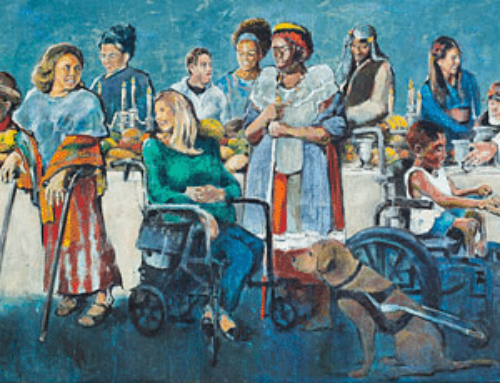 The following is a reflection on/review of the book It’s Hard Not to Stare by Tim Huff, a Toronto-based writer and advocate for people on the margins. Tim has extensive experience with people with exceptional needs, from serving as a Staff Director of the Ontario Camp for the Deaf to ongoing and far-reaching work ministering with people experiencing homelessness. To learn more about Tim, check out his bio here.
The following is a reflection on/review of the book It’s Hard Not to Stare by Tim Huff, a Toronto-based writer and advocate for people on the margins. Tim has extensive experience with people with exceptional needs, from serving as a Staff Director of the Ontario Camp for the Deaf to ongoing and far-reaching work ministering with people experiencing homelessness. To learn more about Tim, check out his bio here.
It’s Hard Not To Stare is available from Amazon and directly from Streetlevel. It is the second book in The Compassion Series, a school-aged program that addresses the complex issues of social justice in a safe, thoughtful and age-appropriate manner. The material encourages children to look at the world through the lens of compassion and understanding, rather than assumptions, judgment or fear, thereby impacting the way they care for and befriend others.
I have never had an average physical appearance. However, due to what I consider a luxury, that is my visual impairment, I rarely notice people staring but it often bothers my family and friends. Sometimes, especially when I run errands on my own, I will overhear the honest curiosity of young children. “Why can’t she walk?” Or “What’s wrong with that lady, why is she in a wheelchair?” Unfortunately, most adults discourage such inquiries. Most often, people respond with one of the following, “Shhhh,” “don’t ask that.” I am not sure if this is most often related to fear of sounding offensive to me or to teach children social filters. What most people do not realize is that these questions usually do not bother me. I have found that in most instances children and some curious adults mean well, they simply want to understand. Rarely, some provide my ideal response which is, “why don’t you ask her?”
These are some of my favorite encounters because they give me an opportunity to inform and educate others. I think this is important in order to resolve curiosity and fear as well as increase compassion in the future. The book “It’s Hard Not to Stare,” well articulates that the intentions behind the looks and questions matter more than the looks and questions themselves. Rather than setting the nearly impossible standard of never steering and someone who looked different it acknowledges the generally positive intentions and desire to help others.
The strength of this book is the way in which it portrays people with all kinds of disabilities so that various differences in appearance and ability may not seem so strange. It suggests that we should look with our hearts and that the desire to understand someone’s appearance or abilities should be motivated by kindness. This principle is reminiscent of 1 Samuel 16:7 which says, “people look at the outward appearance but God looks at the heart.”
“It’s Hard Not to Stare” is in line with a biblical perspective. For example, the first step in Zacchaeus’ redemption was that Jesus’ noticed him at the top of the sycamore tree. Similarly, rather than ignore or disregard the disabled and marginalized Jesus took notice of everyone whom he healed, seeing them for more than their disability or social disgrace and restoring them to community. Thus, I do not think Jesus is calling us to turn a blind eye to our differences but rather to honestly look at one another, truly see each other and recognize that each of us bears the image of God. Further, people with “disabilities” or challenges are more than meets the eye.


